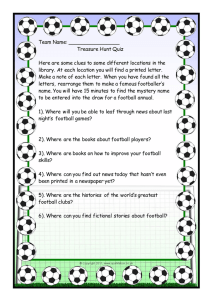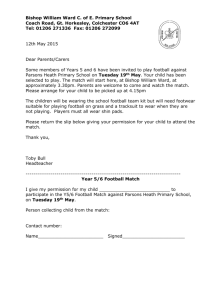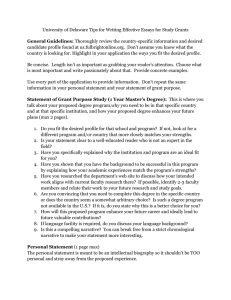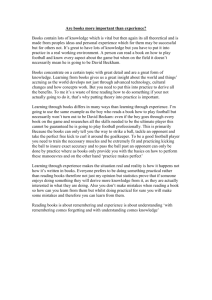Daniel Comstock, Steffanie Fisher, Mary Brodhagen, Katelyn Hartung, Matt McNutt,
advertisement
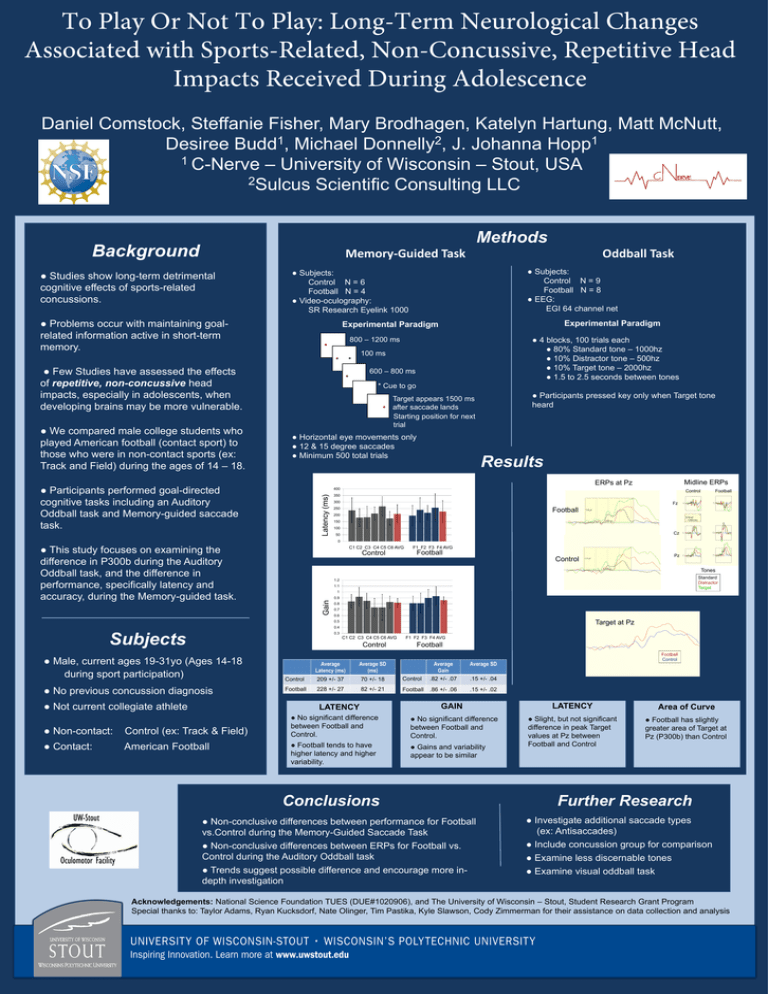
Daniel Comstock, Steffanie Fisher, Mary Brodhagen, Katelyn Hartung, Matt McNutt, 1 2 1 Desiree Budd , Michael Donnelly , J. Johanna Hopp 1 C-Nerve – University of Wisconsin – Stout, USA 2Sulcus Scientific Consulting LLC Methods Background Memory-Guided Task ● Studies show long-term detrimental cognitive effects of sports-related concussions. ● Subjects: Control N = 9 Football N = 8 ● EEG: EGI 64 channel net ● Subjects: Control N = 6 Football N = 4 ● Video-oculography: SR Research Eyelink 1000 ● Problems occur with maintaining goalrelated information active in short-term memory. Experimental Paradigm Experimental Paradigm 800 – 1200 ms ● 4 blocks, 100 trials each ● 80% Standard tone – 1000hz ● 10% Distractor tone – 500hz ● 10% Target tone – 2000hz ● 1.5 to 2.5 seconds between tones 100 ms ● Few Studies have assessed the effects of repetitive, non-concussive head impacts, especially in adolescents, when developing brains may be more vulnerable. ● We compared male college students who played American football (contact sport) to those who were in non-contact sports (ex: Track and Field) during the ages of 14 – 18. Oddball Task 600 – 800 ms * Cue to go ● Participants pressed key only when Target tone heard Target appears 1500 ms after saccade lands Starting position for next trial ● Horizontal eye movements only ● 12 & 15 degree saccades ● Minimum 500 total trials Results Midline ERPs ERPs at Pz ● Participants performed goal-directed cognitive tasks including an Auditory Oddball task and Memory-guided saccade task. Latency (ms) 400 Control Football 350 300 Fz 250 Football 200 150 100 Cz 50 0 ● This study focuses on examining the difference in P300b during the Auditory Oddball task, and the difference in performance, specifically latency and accuracy, during the Memory-guided task. C1 C2 C3 C4 C5 C6 AVG Control F1 F2 F3 F4 AVG Football Pz Control Tones Standard Distractor Target 1.2 1.1 1 Gain 0.9 0.8 0.7 0.6 Target at Pz 0.5 0.4 0.3 Subjects C1 C2 C3 C4 C5 C6 AVG Control ● Male, current ages 19-31yo (Ages 14-18 during sport participation) ● No previous concussion diagnosis ● Not current collegiate athlete Average Latency (ms) Average SD (ms) Control 209 +/- 37 70 +/- 18 Football 228 +/- 27 82 +/- 21 LATENCY ● Non-contact: Control (ex: Track & Field) ● Contact: American Football F1 F2 F3 F4 AVG Football Average Gain Average SD Control .82 +/- .07 .15 +/- .04 Football .86 +/- .06 .15 +/- .02 GAIN ● No significant difference between Football and Control. ● No significant difference between Football and Control. ● Football tends to have higher latency and higher variability. ● Gains and variability appear to be similar Conclusions ● Non-conclusive differences between performance for Football vs.Control during the Memory-Guided Saccade Task ● Non-conclusive differences between ERPs for Football vs. Control during the Auditory Oddball task ● Trends suggest possible difference and encourage more indepth investigation Football Control LATENCY Area of Curve ● Slight, but not significant difference in peak Target values at Pz between Football and Control ● Football has slightly greater area of Target at Pz (P300b) than Control Further Research ● Investigate additional saccade types (ex: Antisaccades) ● Include concussion group for comparison ● Examine less discernable tones ● Examine visual oddball task Acknowledgements: National Science Foundation TUES (DUE#1020906), and The University of Wisconsin – Stout, Student Research Grant Program Special thanks to: Taylor Adams, Ryan Kucksdorf, Nate Olinger, Tim Pastika, Kyle Slawson, Cody Zimmerman for their assistance on data collection and analysis
